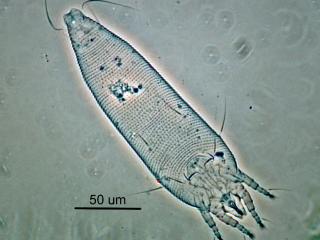Wheat curl mite
Wheat curl mite (WCM) (Aceria tosichella) is the only known vector of WSMV. It is capable of transmitting the virus in its nymphal and adult stages. The mite is tiny, cigar‑shaped and cream-coloured. It can only be seen microscopically due to its small size (<0.3 millimetres (mm) in length) and ability to conceal itself under leaf sheaths and seed glumes (Figure 4). In warm conditions (25-28°C ), WCM can develop from an egg to egg-laying adult in 8-10 days. Females produce about 20 eggs and consequently each female has the potential to produce over three million descendants in 60 days. For this reason, population explosions leading to high WSMV transmission levels can occur in warm weather when temperatures exceed 25°C.
WCM has no wings but is spread within and between crops mainly by wind. The mites are quite short-lived and require a ‘green bridge’ to survive between growing seasons. Their lifespan is 7-10 days at 24-27°C, but up to three months when temperatures approach freezing. As temperature drops their ability to reproduce declines rapidly. Hot, dry summers, typical of the Western Australian wheatbelt, are devastating to WCM populations, which can only persist in surviving pockets of green grass hosts. However, in seasons of high summer and early autumn rainfall, the mites develop large populations on volunteer cereals and other grass hosts and then spread to infest autumn sown cereals, especially wheat.
Green bridge hosts
WSMV and WCM both survive from growing season to growing season in grass weeds or volunteer cereals that grow over summer. Volunteer wheat, barley grass, annual ryegrass, small burr grass, stink grass and witch grass have all been recorded as alternative hosts for WSMV in WA, but some grasses may be non-hosts, for example, windmill grass.
Seed
WSMV is seed-borne at low levels (<1%) in wheat seed. Sowing infected wheat seed stocks produces seed-infected seedlings scattered at random within the crop from which WCM can pick up the virus and spread it to healthy plants. Assuming a wheat crop density of 100 plants per square metre, a seed transmission level of only 0.1% and survival of all seed-infected seedlings, the numbers of WSMV-infected seedlings in the paddock would be 1000 per hectare. This constitutes a considerable infection source from which WCM can pick up the virus and spread it to nearby wheat plants.
Yield losses
Early widespread infection of young wheat plants (approaching 100% infection) is generally associated with greatest yield losses from WSMV and can cause complete crop failure as such crops produce only small amounts of shrivelled grain. Patchy early infection can also cause substantial yield losses within the affected area of crop. These patches are normally circular. There is minimal yield loss when crops become infected post-tillering. The worst case scenario is when a heavily WSMV-infected green bridge is not adequately controlled before sowing an early crop and warm temperatures favour a high WCM population. Then, volunteer wheat and grasses carrying both WSMV and WCM intermingle with the emerging wheat seedlings. The mites rapidly transfer the virus to the seedlings throughout the crop causing 100% early infection (Figure 3).
Seed retention
Crops with less than 1% infection at flowering should have minimal WSMV in the seed harvested, it is likely to be at levels of less than one infected seed in 10 000. It is recommended to avoid harvesting seed from any part of the crop where infection levels are likely to be higher, such as from edges of paddocks, adjacent pasture/fallow, fencelines or road verges were grasses may be present and hosting the virus.
Management options
Serious outbreaks of WSMV can only occur if the mite vector, WCM, is abundant and a source of WSMV is present. Consequently, management of the disease is highly dependent on controlling WCM populations and sources of WSMV.
The control options available against WSMV include:
- Control the ‘green bridge’ (volunteer crop cereals, for example, wheat, barley, cereal rye, oats and grass weeds) as they harbour both WSMV and WCM. This control needs to be done throughout the paddock (including along the fenceline) at least one month before sowing wheat. It needs to be very thorough, involving grazing down to ground level throughout the paddock and early application of herbicide. Neighbouring paddocks should be treated similarly, especially those upwind of the crop. This will ensure the emerging crops are not exposed to early WSMV infection.
- Sow healthy seed stocks of wheat (deemed healthy after seed testing of a representative seed sample).
- Avoid early sowing as warm seasonal conditions in autumn favour high WCM populations.
Unfortunately, there is no effective miticide to spray against the vector and there are as yet no available WSMV-resistant wheat varieties in Australia.

